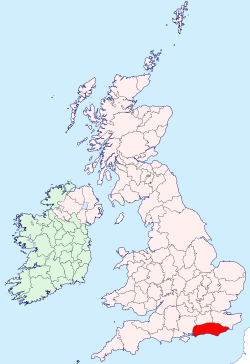
Back Sussex Afrikaans Sūþseaxe ANG ساسكس Arabic Сусекс Byelorussian Съсекс Bulgarian Kontelezh Sussex Breton Sussex Catalan Sussex CEB Sussex Czech Sussex Welsh
| Sussex | |
|---|---|
| Historic county | |
 | |
| Area | |
| • Coordinates | 51°N 0°E / 51°N 0°E |
| History | |
| • Origin | Sub-Roman Britain |
| • Created | 5th century (traditionally 477) |
| Status | Historic county |
| Chapman code | SSX |
| Government | |
| • HQ | Various |
| • Motto | "We wunt be druv" |
| Contained within | |
| • Ceremonial counties | East Sussex • West Sussex |
| Subdivisions | |
| • Type | Rapes (largest & most notable of differing former subdivisions) |
| • Units | |
 | |
Sussex (/ˈsʌsɪks/; from the Old English Sūþsēaxe; lit. 'South Saxons') is an area and cultural region within South East England which was historically a kingdom and later a county. It includes the ceremonial counties of East Sussex and West Sussex.
The kingdom of Sussex emerged in the 5th century from the Roman canton of the Regni and the Iron Age tribal region that preceded it. In about 827, shortly after the Battle of Ellendun, Sussex was conquered by Wessex. From 860 it was ruled by the kings of Wessex and by 927 it was joined by the remaining Anglo-Saxon kingdoms to form the kingdom of England. By the Norman period Sussex was subdivided into administrative districts known as rapes, which were themselves divided into hundreds. By the sixteenth century the eastern three rapes and the western three rapes were combined for most of the meetings of the court of quarter sessions. This arrangement was maintained when administrative counties and independent county boroughs were established in 1889. In Sussex this led to the creation of East Sussex County Council and West Sussex County Council to govern smaller towns and rural areas, while the larger towns were made county boroughs independent of the county councils.
The basic division of Sussex into east and west for the purposes of administration continued in subsequent local government reform. The Lord Lieutenant and Sheriff of Sussex were replaced in 1974 with separate posts for East and West Sussex, with Sussex losing its status as a ceremonial county.
Sussex is bordered by Surrey to the north, Kent to the north-east, the English Channel to the south, and Hampshire to the west. Two-thirds of the population live along its 220 kilometres (137 mi) of coastline or in the Brighton-Gatwick corridor. This includes the city of Brighton and Hove and its wider city region. The rest of the area is sparsely populated and includes large parts of the South Downs National Park and the National Landscapes of the High Weald and Chichester Harbour.
Sussex is recognised as a single cultural region, significant in culture and sport and is used by a range of organisations as a regional unit. In 2007, Sussex Day was created to celebrate the county's culture and history.



